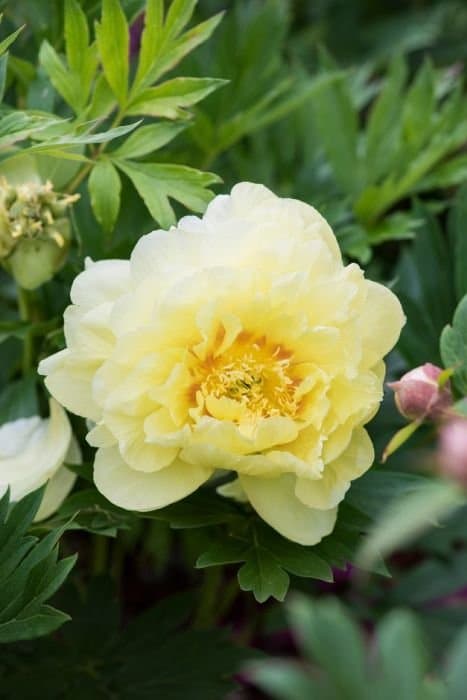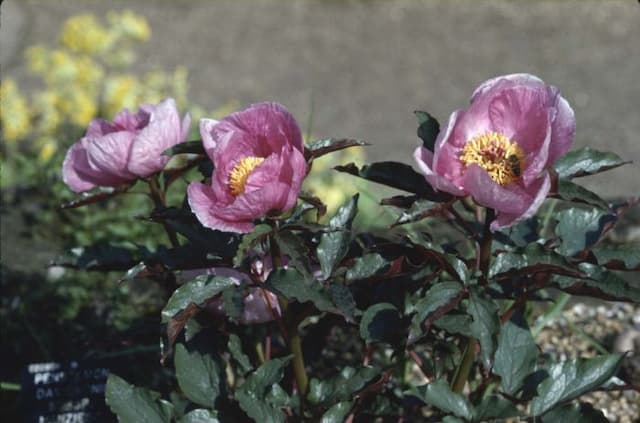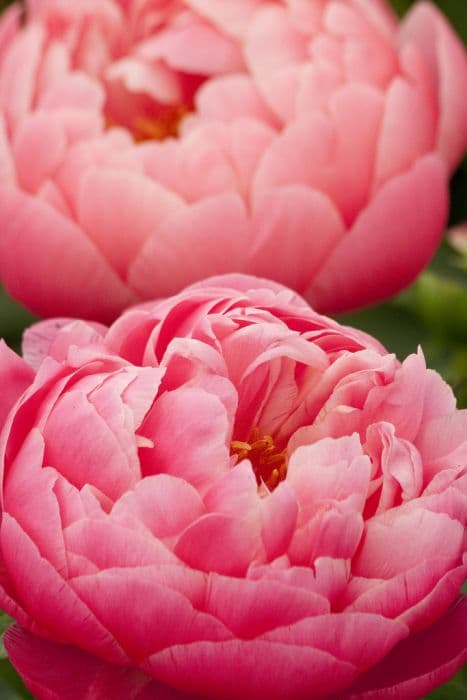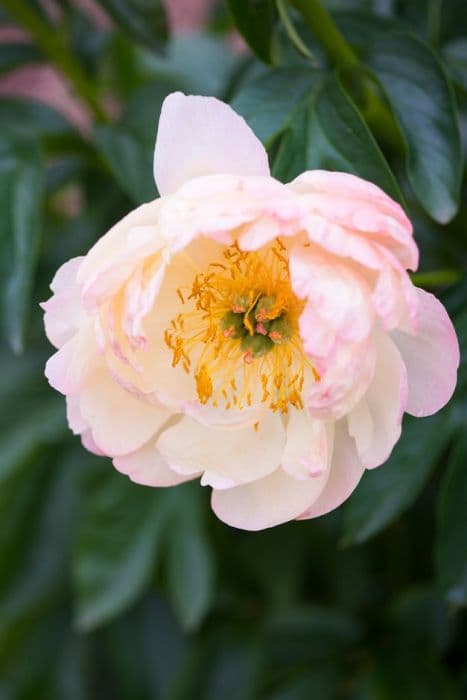Chinese peony Paeonia lactiflora 'Top Brass'

ABOUT
The plant known as 'Top Brass' is a variety of peony that boasts a stunning display of flowers. The blooms of 'Top Brass' are particularly eye-catching with their unique two-tone coloration. The flowers are large and double-form, with a mix of creamy white petals arranged in a dense, ruffled manner around a central core of soft yellow. The white petals can sometimes display hints of blush or ivory, giving the flower a delicate and sublime appearance. These peonies have lush, deep green foliage that creates a bushy backdrop, highlighting the beauty of the flowers. The leaves are broad and glossy, contributing to the overall lush and healthy appearance of the plant. When in bloom, the flowers present themselves prominently above the foliage, creating a dramatic and elegant visual impact. 'Top Brass' peonies emanate a delightful fragrance, which adds to the overall sensory experience of the plant. Their scent is clear and sweet, attracting both admirers and pollinators alike. Although this description bypasses the specific dimensions of the plant, 'Top Brass' peonies make for a striking addition to any landscape, with their combination of visual and olfactory appeal. They bloom in the late spring to early summer, heralding the season with their impressive display.
About this plant
 Names
NamesFamily
Paeoniaceae.
Synonyms
Chinese Peony, Common Garden Peony.
Common names
Paeonia lactiflora 'Top Brass'.
 Toxicity
ToxicityTo humans
The common peony, specifically Paeonia lactiflora 'Top Brass', is considered non-toxic to humans. There are no significant toxic effects expected from ingesting parts of this plant. However, it's always good practice to avoid ingesting plants not meant for consumption as they can cause gastrointestinal discomfort or allergic reactions in some people.
To pets
The common peony, which includes Paeonia lactiflora 'Top Brass', is generally considered to be of low toxicity to pets. If a pet were to ingest part of this plant, mild gastrointestinal upset including vomiting and diarrhea might occur. These symptoms are typically not severe, but if your pet consumes a large quantity of the plant or shows signs of distress, consult a veterinarian.
 Characteristics
CharacteristicsLife cycle
Perennials
Foliage type
Deciduous
Color of leaves
Green
Flower color
Pink
Height
2-3 feet (60-90 cm)
Spread
2-3 feet (60-90 cm)
Plant type
Herb
Hardiness zones
3-8
Native area
China
Benefits
 General Benefits
General Benefits- Aesthetic Appeal - Paeonia lactiflora 'Top Brass', commonly known as Peony, boasts large, attractive flowers that add visual interest to gardens and landscapes.
- Fragrance - Peonies are well-known for their pleasant and often strong fragrance that can perfume an entire garden space.
- Longevity - Peonies are extremely long-lived plants, often living for 50 years or more with proper care, providing generations of enjoyment.
- Cut Flowers - The blooms of the Peony make excellent cut flowers, holding up well in vases and adding elegance to indoor arrangements.
- Pollinator Friendly - Peonies attract beneficial pollinators like bees and butterflies to the garden, which are important for the health of the ecosystem.
- Versatility - With their lush foliage, Peonies provide a beautiful backdrop for other plants and can be used in borders, beds, or as standalone specimens.
- Seasonal Interest - Peonies bloom in late spring to early summer, offering a seasonal display when many other plants are not yet at their peak.
- Deer Resistance - Peonies are generally resistant to deer, which makes them suitable for gardens in areas with high deer populations.
 Medical Properties
Medical Properties- Anti-inflammatory: Peony may help reduce inflammation in various parts of the body.
- Analgesic effects: It has been used historically to alleviate pain, especially in traditional Chinese medicine.
- Immunomodulatory effects: Some studies suggest that peony compounds could modulate the immune system.
- Neuroprotective effects: There are indications that peony extracts might have a protective effect on the nervous system.
 Air-purifying Qualities
Air-purifying QualitiesThis plant is not specifically known for air purifying qualities.
 Other Uses
Other Uses- Textile dyeing: The petals of Paeonia lactiflora 'Top Brass' can be used to create a natural dye for fabrics, giving them a soft, pink hue.
- Culinary garnish: The flowers can be used as an elegant garnish for salads and desserts, adding a splash of color and subtle floral notes to dishes.
- Photography: The striking appearance of Paeonia lactiflora 'Top Brass' makes it a popular subject for photographers, particularly in macro photography to capture its intricate details.
- Artistic inspiration: The plant's dramatic blooms and foliage are often used by artists as a reference for botanical illustrations and paintings.
- Wedding decor: The full, lush flowers are commonly used in wedding bouquets and centerpieces due to their romantic look and range of soft colors.
- Eco-friendly confetti: Dried petals of Paeonia lactiflora 'Top Brass' can be used as biodegradable confetti, offering an environmentally friendly alternative to traditional confetti.
- Perfumery: While not as common as other flowers, peony petals can be used in the preparation of certain perfumes, adding a floral note to the fragrances.
- Floral arrangement workshops: The plant is often featured in floral design classes, where its blooms are a favorite due to their volume and ability to create visually impactful arrangements.
- Crafting: The robust petals of Paeonia lactiflora 'Top Brass' can be used in crafting, for example, in creating paper or silk flowers for home decor.
- Plant dye for art materials: Beyond textile dyeing, the natural pigments extracted from the plant can be used to color papers, glues, and other crafting materials.
Interesting Facts
 Feng Shui
Feng ShuiThe Peony is commonly used in Feng Shui to promote romance and prosperity. Often associated with wealth and honor, it is best placed in the southwest sector of the garden or home to enhance love and marriage prospects. In Feng Shui, it is particularly beneficial for those seeking a romantic partnership or wanting to nourish existing relationships.
 Zodiac Sign Compitability
Zodiac Sign CompitabilityThe Peony is not used in astrology practice.
 Plant Symbolism
Plant Symbolism- Prosperity: Peonies like the Paeonia lactiflora 'Top Brass', commonly known as the Chinese peony, often symbolize prosperity due to their lush, full blossoms and rich colors, which historically were associated with wealth and success in Eastern cultures.
- Romance: The luxurious and often fragrant blossoms of the Chinese peony are also linked to romance and romantic love, embodying the ideal of beauty and attracting positive feelings in relationships.
- Honor: In many societies, particularly in their traditional use in Chinese culture, peonies are considered a symbol of honor and high social status, as well as the respect that comes with both.
- Beauty: With their striking and voluptuous flowers, peonies epitomize beauty in the plant world, making them a symbol of physical and sometimes inner beauty as well.
- Good Fortune: The Chinese peony is often associated with good luck and fortune; it's a popular choice in festive occasions like weddings and New Year celebrations, intended to bring positive outcomes to the participants.
- Compassion: Some interpretations ascribe a symbol of compassion to the peony, as its gentle appearance can evoke a sense of nurturing care and empathy.
 Water
WaterFor the peony 'Top Brass', water sparingly as peonies do not like excessive moisture around their roots. Typically, watering once a week with about 1 gallon of water will suffice, especially if there has been no significant rainfall. During the growing season, ensure the soil is moist but not waterlogged. Reduce watering after the blooming period as the plant prepares for dormancy. Avoid watering the foliage directly to prevent fungal diseases.
 Light
LightPeonies like 'Top Brass' thrive best in full sun to light afternoon shade. They require at least 6 hours of sunlight daily to bloom properly. The ideal spot is where they can receive bright, morning light, which is less intense than the afternoon sun. Avoid deeply shaded areas as this will reduce blooming and can lead to disease.
 Temperature
TemperatureThe peony 'Top Brass' prefers a temperate climate. The ideal temperature range for growth and flowering is between 65°F and 75°F. They are cold hardy and can withstand winter temperatures as low as -20°F. During active growth in the spring and summer, avoid exposure to temperatures above 85°F for prolonged periods to prevent heat stress.
 Pruning
PruningPrune 'Top Brass' peonies in the fall after the foliage has died back to reduce overwintering diseases and pests. Remove any spent flowers during the blooming season to encourage new blooms. Pruning is typically done annually, and the best time is when the plant is dormant, often after the first hard frost.
 Cleaning
CleaningAs needed
 Soil
SoilThe best soil mix for Peony 'Top Brass' should be rich, fertile, and well-draining with a pH of 6.5 to 7.0. Incorporate organic compost or well-rotted manure into the planting hole, and consider a mixture of two parts loam, one part peat moss or compost, and one part perlite or coarse sand for optimal drainage and nutrition.
 Repotting
RepottingPeony 'Top Brass' typically does not need to be repotted often as it is a perennial garden plant. It can remain in the same location for many years; however, if it is grown in a container, it should be repotted every 3 to 5 years to refresh the soil and accommodate root growth.
 Humidity & Misting
Humidity & MistingPeony 'Top Brass' is adaptable to a range of humidity levels and does not require specific humidity conditions. It thrives best in the open garden where natural humidity is present and does not need any special humidity adjustments.
 Suitable locations
Suitable locationsIndoor
Peonies, like 'Top Brass,' struggle indoors; provide bright light and cool temps.
Outdoor
Plant in fertile soil; full sun; spacing 3-4 feet; mulch; avoid wet areas.
Hardiness zone
3-8 USDA
 Life cycle
Life cycleThe Chinese peony 'Top Brass' begins its life cycle with seed germination, which typically occurs in the spring once the temperature is warm enough to encourage sprouting. Following germination, the seedling develops a root system and foliage, growing into a young plant. As the plant matures, it undergoes vegetative growth, developing lush green leaves and stems. After reaching maturity, usually within a few years, 'Top Brass' enters its reproductive stage, producing large, fragrant white flowers with yellow center tufts, typically flowering in late spring to early summer. Post-blooming, the peony sets seeds in pods that, once mature, burst open to disperse seeds for the next generation. Finally, as a perennial, 'Top Brass' dies back to the ground in fall after the first frosts, with its roots surviving winter to regenerate the next spring.
 Propogation
PropogationPropogation time
Spring
The most popular method of propagation for Paeonia lactiflora 'Top Brass', commonly known as the Chinese peony, is through root division. This method is ideally performed in the fall after the plant has died back following the first frost. To propagate by division, carefully dig up the peony plant, ensuring a sizable amount of root is attached to each section. Each division should have at least three to five eyes, which are the small reddish-brown buds found on the crown of the root. After cutting the root into sections with a sharp knife, each piece can be replanted in a hole deep enough to allow the eyes to be positioned 1 to 2 inches (approximately 2.5 to 5 cm) below the surface of the soil, with ample space for roots to grow. Water the newly planted divisions thoroughly to settle the soil around the roots. This propagation method allows the development of new plants that are genetically identical to the parent and ensures the continuation of the 'Top Brass' specific characteristics.









